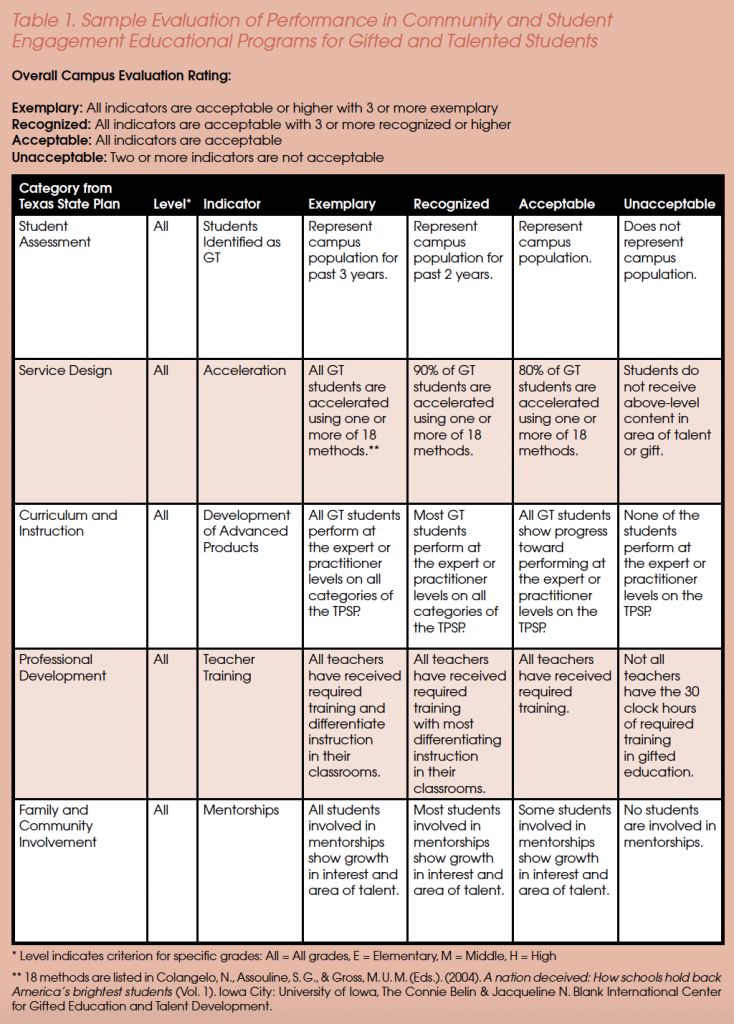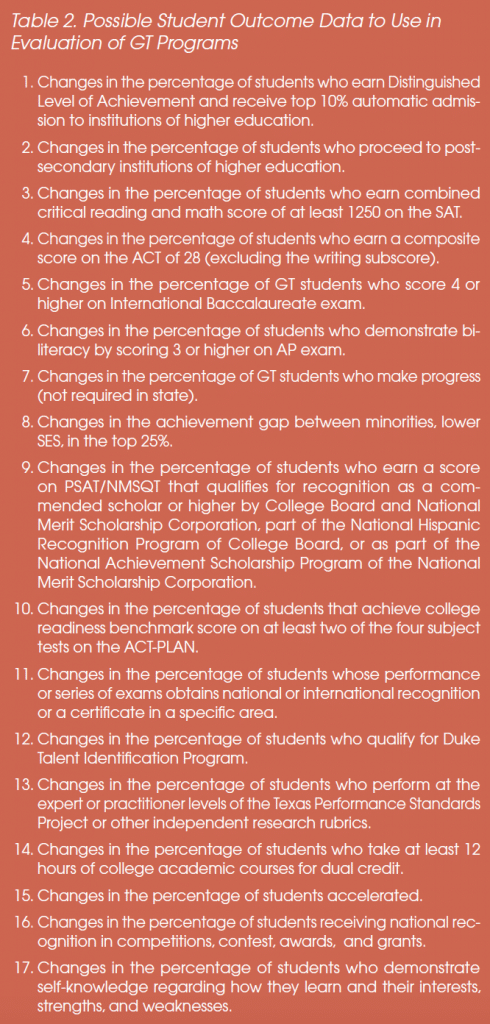Educational equity does not mean educational sameness. Equity respects individual differences in readiness to learn and recognizes the value of each student. Colangelo, Assouline, and Gross (2004, p. 2)
Ten years ago, A Nation Deceived described how schools held back their brightest students (Colangelo, 2004). The authors asserted, “When we tell ourselves that our brightest students would not benefit from acceleration, we deceive ourselves, our students, and the nation” (p. 1). They suggested, “The cornerstone of education is the flexibility to recognize the needs of the individual child” (p. 9). Since this report, how far has education come in serving all of its gifted and talented students? What has influenced these results? This article focuses on these questions and provides some suggestions for ways that educators might gifted education programs in their schools.
How far have we come?
Policies and practices in gifted education have never been consistent across states and are not consistent across school districts even within the same state. For example, only 23 states out of 42 who responded to the 2012–2013 National Association for Gifted Children (NAGC) survey mandate both identification and services for gifted students (CSDPG & NAGC, 2013). Texas does mandate identification of gifted students in grades K–12 and services in four core content areas, but school districts make the decision about how they will identify, serve, and use the state-weighted funding. Most states report the resource room as their top delivery model at the elementary level and advanced coursework or Advanced Placement (AP) at the middle and high school levels (CSDPG & NAGC, 2013). Interestingly, in Texas the regular classroom was listed as the most common model at the elementary level followed by cluster classrooms (CSDPG & NAGC, 2013). It’s unclear from the NAGC report how many districts in Texas use specific delivery models and what services might be received in the regular classroom.
These differences in programming were investigated further by a 2014 survey conducted by the National Research Center on the Gifted and Talented at the University of Virginia (Callahan, Moon, & Oh, 2014). In their survey of district coordinators and directors of gifted education programs in 2,000 elementary schools, 1,753 middle schools, and 1,160 high schools, they found that no particular framework was used to guide decisions regarding the gifted education programs (32.1% at the elementary, 40.2% at the middle, 34.1% at the high school level), no particular curriculum materials were used except for AP materials at the high school, and that 75–99% of the identified students were served by one primary model at the middle and high school levels. The authors expressed concern that these results suggested a one-size-fits-all approach to services that runs counter to research—gifted students are not a homogeneous group with the same learning needs (Callahan et al., 2014; Reis & Renzulli, 2009). In addition, they reported that only 8% of elementary programs used student outcomes to improve their services and more than 50% said they used no evaluation of their overall program at all.
Callahan et al. (2014) also reported the representation of minority and economically disadvantaged students varied widely across school districts, with only 50% of elementary school districts reporting an exact alignment with the school district population as a whole. Notably, underrepresentation of students in poverty was greater for Black or Hispanic students, with more than 50% of the respondents across school levels reporting much lower representation of students in poverty.
Texas reports similar underrepresentation for the school year 2012–2013 (TEA, 2013b). While Blacks comprised 12.7% of the overall population, only 6.6% were enrolled in gifted programs. Similarly, Hispanics comprised 51.3% of the population but only 40.6% were in gifted programs. The greatest disparity was for economically disadvantaged students. Although they comprised 60.3% of all students, only 38.1% were in gifted and talented programs.
These disparities in services appear to have long-term consequences for unequal learning opportunities. Recent reports have shown:
Disparities in advanced achievement. Low-income and minority students are much less likely to reach advanced levels of proficiency on state or national assessments (Plucker, Burroughs, & Song, 2010). In Texas while 17% of grade 4 students scored advanced in math, only 3% of those eligible for free/reduced lunch did (Plucker et al., 2013). Moreover, the gap in Texas doubled for White vs. Black students and White vs. Hispanic students since 2003 (Plucker et al., 2010).
High achievers’ performance tends to decline over time. Only 57.3% of high-achieving third-grade math students remained high achievers by eighth grade while 55.9% remained so in reading. Only 8.2% of minority students were represented in these high-achieving groups. Low- and middle-achieving students demonstrated faster rates of improvement than high achievers (Xiang, Dahlin, Cronin, Theaker, & Durant, 2011).
Gaps at the advanced levels have widened. Although minimum competency gaps among different minority and economic groups have been reduced during the era of NCLB, gaps at the advanced levels are significant among different racial groups, high- and low-socioeconomic status, and different levels of English language proficiency (Education Trust, 2013; Plucker et al., 2010; Plucker, Hardesty, & Burroughs, 2013). The differences between proficient and advanced is important because advanced represents a greater degree of critical thinking and an ability to communicate, generalize, and explain answers (Education Trust, 2013).
Inequities in applications to selective colleges. Despite being qualified for admission, the vast majority of low-income high achievers do not apply to any selective college (Hoxby & Avery, 2013). Moreover, selective colleges generally cost less because of generous financial aid than 2-year and 4-year institutions and graduate more students. Only one in 17 children from families with less than $35,000 annual income obtains a bachelor’s degree by age 24 (National Academy of Sciences, National Academy of Engineering, & Institute of Medicine, 2010).
In summary, policies and practices for gifted education vary in the United States across and within states. Although Texas mandates identification and services in the core content areas for gifted and talented students in grades K–12, individual districts services vary with the “regular classroom” and advanced courses mentioned as the most common models at elementary and secondary levels respectively. Even more significantly, low- and middle-achieving students demonstrate faster rates of improvement than high achievers. Similar to national trends, Texas provides unequal learning opportunities for gifted and talented students who are minorities and/or from low-income backgrounds. These disparities have long-term consequences, particularly in a state where the minority is now the majority (56% vs. 44%; United States Census, 2013).
What has influenced these results?
Researchers have described a variety of reasons for these inequities and discouraging results: high-stakes testing, tightly-aligned curriculum, misaligned program services, lack of monitoring and accountability, and teacher education.
High-Stakes Testing
Texas has developed assessments to measure students’ performance on the State Assessments of Academic Readiness (STAAR) and end-of-course assessments. These are used for accountability and in determining the performance of public school districts and campuses. While House Bill 5 provides distinction designations, standards must be met first before these are applied. Therefore, most school districts, particularly those with higher percentages of low-income students, focus on low-performing students’ achievement, not on the growth of advanced students. This emphasis has led schools to develop interim benchmark assessments to determine if teachers and students are on track for covering the standards that are included in the state assessments. Teachers, in turn, focus on students who are not performing on specific standards, which results in a remedial, deficit-based curriculum that is narrowed into decontextualized skill-based instruction. This type of curriculum reduces the motivation of gifted and talented students to engage in learning (Moon, 2009). In addition, even high achievers suffer under the threat of school sanctions if they don’t show competence on state- and school-district-developed benchmark tests (Ladd & Lauen, 2010; Lauen & Gaddis, 2012). Graded tests that focus on proficiency often don’t measure rigorous curriculum and have too low a ceiling to assess above-level content. Because of these limitations, gifted students’ knowledge and skills are not assessed and growth is therefore difficult to determine (Gentry, 2006; Moon, 2009; Rakow, 2008). Even with growth models, Ryser and Rambo-Hernandez (2014) suggest that they are designed for measuring proficiency in typically developing children and therefore will contain error, ceiling effects, and regression toward the mean when used with gifted learners.
Tightly-Aligned Curriculum
Because of the desire to improve students’ performance on state-mandated assessments, some school districts have tightly aligned their curriculum. Curriculum alignment is the extent to which there is a match between standards in at least one of three categories—written curriculum, instruction, and assessment (Porter, 2002; Squires, 2012; Webb, 1997, 2002). The written curriculum is usually the curriculum documents or frameworks produced or adopted by the school district; the instructional curriculum is the written curriculum taught by teachers in their classrooms; and the assessed curriculum consists of formative, ongoing, and summative assessments such as curriculum-embedded tests, benchmark tests, and state standardized tests. The goal of alignment is to create a seamless progression for students from one level to the next. While curriculum alignment has the worthy goal of ensuring that all students experience the same opportunities to learn (CCSRI, 2009; Squires, 2012), a standard, one-size-fits-all curriculum does not work for gifted and talented students who are frequently above level and need acceleration (Kettler, 2007; Ryser & Rambo-Hernandez, 2014). Mandated pacing guides, common lesson plans among teachers at a specific grade level, and scripted lessons leave little time for student-driven curriculum based on readiness and interests (Hargrove, 2008; Hill, 2013; Rakow, 2008). The result is lower measured rates of achievement among gifted and talented students. In addition, AP courses are not appropriate for serving all gifted and talented students (Callahan et al., 2014). Students may have gifts and talents in a variety of domains. In fact, in their survey of 48 college-bound students from low-income backgrounds, Hallett and Venegas (2011) reported that the content studied in AP classes was at a lower level than the content of the AP national exams, teachers appeared to be unprepared to teach the classes, and the students from low-income and minority backgrounds who took these courses were not prepared for college and university settings. In Texas, less than half of the students (47.9%) who took AP exams made a score greater than 3 as compared to 58.8% nationally (TEA, 2013a).
Misaligned Program Services
The CSDPG and NAGC (2013) reported that elementary and secondary delivery models varied. At the elementary level, the majority of gifted education programming is delivered in a regular classroom, cluster, or resource room model; at the secondary level, advanced courses and AP are the most prevalent, which is also true in Texas. Moreover, in Texas the percentage of students participating in gifted and talented programs has decreased from 8.4% of enrollment in 2000–2001 to 7.6% in 2012–2013 (TEA, 2013b). This decrease may relate to fewer gifted education teachers who provided not only identification and resource services but also advocated for gifted education programs. The misalignment of services does not provide for the continuous development of advanced students’ talents and gifts (Ambrose, VanTassel-Baska, Coleman, & Cross, 2010; Brown, Avery, VanTassel-Baska, Worley, & Stambaugh, 2006). Most students receive the same program model at the elementary level and often a different one at the secondary level, leaving to chance the development of a student’s talents or gifts.
Lack of Monitoring and Accountability
The Texas Education Agency (n.d.) provides guiding questions for program review related to the Texas State Plan for the Education of Gifted and Talented Students (TEA, 2009). All of the questions are process or input driven and do not examine student outcomes. For example, the question, “What district policies allow opportunities for student acceleration in areas of strength?” (TEA, n.d., p. 5), focuses on the presence or absence of a policy rather than the percentage of students who actually were accelerated and the effects of acceleration on students’ achievement. This attention on process is similar to the results from Callahan et al.’s (2014) survey. They reported, “While the district program goal statements that were provided acknowledged the educational needs of gifted students, student learning outcome goals were rarely reported by respondents across all school levels” (p. 6). Given this emphasis on process and the lack of on-site monitoring in Texas, it’s difficult to know if school districts are actually providing for the needs of gifted and talented students. Brown et al. (2006) suggested that when states give the responsibility of implementing state requirements to local districts, they need to have some way of documenting how school district decisions impact programming for gifted learners.
Limited Professional Development
General education teachers report fear about their positions if their students receive lower scores than those previously reported; hence, they spend a large amount of their effort focused on proficiency (Mendoza, 2006). They need to have professional development in the area of differentiation. Callahan et al. (2014) found that less than 5 hours per school year were devoted to professional development on the education of gifted students at the secondary level and ranged from as low as 15 minutes to 4 days per year at the elementary level. In addition, most general education teachers are unlikely to have received any training or professional development in gifted education (CSDPG & NAGC, 2013). In Texas, educators who teach gifted and talented students need only 30 clock hours of professional development, which is less than one course at the university level (i.e., 45 clock hours). While 6-hour updates are required each year, they may be related to any of the teacher education standards. Notably, few general education teachers receive any gifted preparation in their undergraduate program, and GT in-service training for general education teachers is left to the local school districts. Because most gifted students spend the majority of their time in general education classrooms, this limited preparation is important to consider because of the gifted students’ needs for differentiated and acceleration learning opportunities.
How might we address these challenges?
Most gifted educators are aware of these influences on the education of gifted and talented students. The important question is how do we address these challenges? Some possible solutions are described below.
Use Balanced Assessments Appropriate for Gifted and Talented Students
In addition to periodic benchmark tests and state-mandated tests, general education and gifted education teachers should collect direct and frequent samples of student performance before, during, and after instruction. These varied assessments provide the most meaningful information regarding students’ strengths and weaknesses and are useful in instructional planning (Johnsen & Sulak, 2013). For gifted and talented students, these assessments need to be above level so that they are able to show students’ knowledge and skills learned at a higher grade level or in more advanced courses. Computer-adaptive testing options, which advance a student who performs well to successively more difficult items, are useful in determining the student’s readiness for accelerated content (Ryser & Rambo-Hernandez, 2014). Teachers will also want to include more nontraditional measures such as products and performances to assess complex thinking. The Texas Performance Standards Project (TEA, 2006–2012), which is suggested in the Texas State Plan (see 3.2C in TEA, 2009), might examine the students’ development of independent learning and research. Effective nontraditional assessments for gifted and talented students should include problems that (a) occur in authentic environments, (b) are novel to the students, (c) require students to transfer previously acquired knowledge and skills, (d) require students to analyze the influences of contextual factors on problem analysis, (e) require students to argue for their ideas on the basis of various relevant perspectives, and (f) integrate knowledge across domains (Baxter & Shavelson, 1994; Segers, 1997; Segers, Dochy, & DeCorte, 1999; Shavelson, Gao, & Baxter, 1996). (See Johnsen & Sulak, 2013, and Sulak & Johnsen, 2012, for other tools to assess gifted students’ development in the academic, personal, and social areas.) As data are collected, the teacher can determine the developmental readiness for specific grade or course bands of standards, create flexible groups, and differentiate the curriculum (Kaplan, 2014; Moon, 2009).
For those districts meeting standards, House Bill 5 does provide distinction designations for campuses that show greater than expected progress for the top 25% and close performance gaps of the top 25%. Having assessments that actually show progress among gifted and talented students will be a plus not only for an individual school but also for the entire school district. In addition, students who show that they are ready and actually receive accelerated learning opportunities are more likely to score higher on AP, SAT, and ACT exams and other indicators for distinction and college readiness (Colangelo et al., 2004; Rogers, 2007).
Differentiate Curriculum
Given the rigidity of curriculum, how might teachers differentiate the TEKS? Recent books on the Next Generation Science Standards and the Common Core State Standards in math and English language arts show some excellent examples of ways to differentiate a standard for typical and advanced students (Adams, Cotabish, & Ricci, 2014; Hughes-Lynch, Kettler, Shaunessy-Dedrick, & VanTassel-Baska, 2014; Johnsen, Ryser, & Assouline, 2014; Johnsen & Sheffield, 2013; VanTassel-Baska, 2013). Although Texas is not a Common Core state, the suggestions for differentiation are applicable to the TEKS as well. They include these strategies: accelerating knowledge and skills, varying the pace within learning activities, encouraging creativity through open-ended activities, adding depth, making interdisciplinary connections, identifying themes and broad-based concepts, using higher level questioning, including global issues in the curriculum, engaging students in research investigations of interest to them, and involving students in extracurricular activities such as mentorships and apprenticeships, online games and courses, Saturday and summer programs, and competitions. Administrators need to provide time, flexibility, and autonomy to teachers who differentiate the prescribed curriculum to meet the individual needs of their students.
Align Program Services to Students
Gifted students need to be served in their area(s) of talent every day—not just while they are in the gifted program. Programming refers to a “flexible system of viable service options . . . that meet the needs and reinforce the strengths and interests of gifted/talented students (TEA, 2009, p. 8). Domains of talent have different developmental trajectories (Olszewski-Kubilius, 2012). Support needs to begin early and needs to change as the talent evolves (Subotnik, Olszewski-Kubilius, & Worrell, 2011). For example, mathematical ability can be recognized as early as preschool. Children with this talent need to have opportunities to enhance not only their knowledge but also their interest and passion for the field (Johnsen & Sheffield, 2013). This might mean early acceleration in mathematics, participating in math contests, collaborating with like-ability peers in a math club, conducting interdisciplinary investigations that incorporate mathematics, and working with a mentor at a university on a statistics project. Programs therefore need to be focused on nurturing, developing, and maintaining domain-related interests from elementary through secondary and into higher education settings.
Provide Professional Learning for All Teachers
Professional learning is critical for all educators and administrators to learn ways of differentiating for gifted and talented students. This training includes administrators, coordinators, curriculum specialists, general education, special education, and gifted education teachers. As noted in the NAGC Programming Standards (NAGC, 2010), “Professional development may take many forms ranging from district-sponsored workshops and courses, university courses, professional conferences, independent studies, and presentations by external consultants” (p. 13). All of these forms need to be aligned to teachers’ needs with systematic follow up (Pierce et al., 2001). Teachers need to (a) view other teachers who model best differentiation practices; (b) have materials support that includes balanced assessments, evidence-based curricula, and materials for independent use and research; and (c) have human support that provides follow up, co-teaching opportunities, and collaboration. Differentiation takes time and practice and needs to be developed in a risk-free environment. The school needs to develop a culture that is supportive of research-based teaching practices with gifted and talented students and that lends itself to acceleration, interest-driven student projects, and interdisciplinary learning opportunities.
Engage the Community in Student Learning Outcome Goals
House Bill 5 requires school districts to evaluate each campus in the district in community and student engagement and in compliance. One of the areas that needs to be evaluated is educational programs for gifted and talented students. Once a local committee develops criteria, the school district assigns each campus a performance rating of exemplary, recognized, acceptable, or unacceptable for both overall performance and each individual evaluation factors (see Sec. 39.0545 of House Bill 5). This evaluation needs to be made publicly available no later than August 8 of each year. This new bill has great potential for improving services for gifted and talented students as long as the criteria are focused more on student learning outcomes rather than process goals (see Table 1).

Table 1 shows one example of an outcome for each of the categories from the Texas State Plan. For example, instead of saying that multiple measures are used to identify students for gifted and talented programs, the rubric focuses on the representation of the students from minorities and lower socioeconomic groups that are actually served in the program. Other outcome indicators for the assessment category might include the percentage of students nominated and referred from each of the subgroups or the alignment of assessments with specific gifts and talents (e.g., the percentage of students served in each area of the state definition). More possible student outcomes that might be used by the committee for evaluating gifted and talented programs are included in Table 2. In Table 2, you will notice that all of the learning outcomes examine changes in percentage of students to acknowledge the value that is added by different components of the program.

Conclusions
A variety of influences tend to discourage the implementation of gifted and talented programs in Texas. These include high-stakes testing, tightly-aligned curriculum, misaligned program services, lack of monitoring and accountability, and limited professional development. Solutions that are considered in this article include the use of balanced assessments, differentiation of the curriculum, alignment of services to students’ gifts and talents, provision of professional development for all administrators and teachers, and community engagement in the evaluation process. This latter solution, which is a part of House Bill 5, provides gifted educators with an excellent opportunity for examining the effectiveness of different gifted education program components if the evaluation focuses on outcomes instead of process indicators. This focus is critical in improving services to gifted and talented students.
References
Adams, C. M., Cotabish, A., & Ricci, M. C. (2014). Using the Next Generation Science Standards with gifted and advanced learners. Waco, TX: Prufrock Press.
Ambrose, D., VanTassel-Baska, J., Coleman, L. J., & Cross, T. L. (2010). Unified, insular, firmly policed, or fractured, porous, contested, gifted education? Journal for the Education of the Gifted, 33, 453–478.
Baxter, G. P., & Shavelson, R. J. (1994). Science performance assessments: Benchmarks and surrogates. International Journal of Educational Research 21, 279–299.
Brown, E., Avery, L., VanTassel-Baska, J., Worley, B. B., & Stambaugh, T. (2006). A five-state analysis of gifted education policies. Roeper Review, 29, 11–23.
Callahan, C. M., Moon, T. R., & Oh, S. (2014). National surveys of gifted programs: Executive summary 2014. Charlottesville, VA: National Research Center on the Gifted and Talented, University of Virginia Curry School of Education. Retrieved from http://nagc.org.442elmp01.blackmesh.com/sites/default/files/key%20reports/
2014%20Survey%20of%20GT%20programs%20Exec%20Summ.pdf
Center for Comprehensive School Reform and Improvement. (2009, August). Issue brief: Vertical alignment: Ensuring opportunity to learn in a standards-based system. Washington, DC: Author.
Colangelo, N., Assouline, S. G., & Gross, M. U. M. (Eds.). (2004). A nation deceived: How schools hold back America’s brightest students (Vol. 1). Iowa City: University of Iowa, The Connie Belin & Jacqueline N. Blank International Center for Gifted Education and Talent Development. Retrieved from http://www.accelerationinstitute.org/nation_deceived/nd_v1.pdf
Council of State Directors of Programs for the Gifted, & National Association for Gifted Children. (2013). 2012–2013 State of the states in gifted education: National policy and practice data. Washington, DC: NAGC.
Education Trust. (2013). Breaking the glass ceiling of achievement for low income students and students of color. Washington, DC: Author. Retrieved from http://www.edtrust.org/dc/resources/publications?page=1
Gentry, M. (2006). No Child Left Behind: Neglecting excellence. Roeper Review, 29, 24–27.
Hallett, R. E., & Venegas, K. M. (2011). Is increased access enough? Advanced Placement courses, quality and success in low-income urban schools. Journal for the Education of the Gifted, 34, 468–487.
Hargrove, K. (2008). From the classroom: Meeting social and emotional needs in the days of high-stakes testing. Gifted Child Today, 31(3), 45–46.
Hill, K. D. (2013). Reclaiming students’ voices: Fourth graders’ discussion of the great migration in a climate of paced curriculum. Journal of Advanced Academics, 24, 141–163.
Hoxby, C., & Avery, C. (2013). The missing “one-offs”: The hidden supply of high-achieving, low-income students. Retrieved from the Brookings Institute http://www.brookings.edu/~/media/projects/bpea/spring%202013/2013a_hoxby.pdf
Hughes-Lynch, C. E., Kettler, T., Shaunessy-Dedrick, E., & VanTassel-Baska, J. (2014). A teacher’s guide to using the Common Core State Standards with gifted and advanced learners in the English Language Arts. Waco, TX: Prufrock Press.
Johnsen, S. K., Ryser, G. R., Assouline, S. (2014). The practitioner’s guide for using the Common Core State Standards for mathematics. Waco, TX: Prufrock Press.
Johnsen, S. K., & Sheffield, L. J. (Eds.). (2013). Using the Common Core State Standards for mathematics with gifted and advanced learners. Waco, TX: Prufrock Press.
Johnsen, S. K., & Sulak, T. N. (2013). Screening, assessment, and progress monitoring. In M. R. Coleman & S. K. Johnsen (Eds.). Implementing RtI with gifted students: Service models, trends, and issues (pp. 23–45). Waco, TX: Prufrock Press.
Kaplan, S. N. (2014). Emphasizing the uncommon about the Common Core State Standards. Gifted Child Today, 37, 126–127.
Kettler, T. (2007). An administrator’s perspective: Gifted education left behind and run over. Gifted Child Today, 30, 42–43.
Ladd, H. F., & Lauen, D. L. (2010). Status versus growth: The distributional effects of school accountability policies. Journal of Policy Analysis and Management, 29, 425–450.
Lauen, D. E., & Gaddis, S. M. (2012). Shining a light or fumbling in the dark? The effects of NCLB’s subgroup-specific accountability on student achievement. Educational Evaluation and Policy Analysis, 34, 185–208.
Mendoza, C. (2006). Inside today’s classrooms: Teacher voices on No Child Left Behind and the education of gifted children. Roeper Review, 29, 28–32.
Moon, T. R. (2009). Myth 16: High-stakes tests are synonymous with rigor and difficulty. Gifted Child Quarterly, 53, 277-279.
National Academy of Sciences, National Academy of Engineering, & Institute of Medicine. (2010). Rising above the gathering storm, revisited: Rapidly approaching category 5. Washington, DC: National Academies Press.
National Association for Gifted Children. (2010). NAGC pre-K-grade 12 gifted programming standards: A blueprint for quality gifted education programs. Washington, DC: Author.
Olszewski-Kubilius, P. (2012). Building on the best of gifted education with programming for talent development. Tempo, 32(2), 8–11, 40.
Pierce, R. L., Cassady, J. C., Adams, C. M., Speirs Neumeister, K. L., Dixon, F. A., & Cross, T. L. (2001). The effects of cluster and curriculum on the development of gifted learners’ math achievement. Journal for the Education of the Gifted, 34, 569–594.
Porter, A. C. (2002). Measuring the content of instruction: Uses in research and practice. Educational Researcher, 31(7), 3–14.
Plucker, J. A., Hardesty, & Burroughs, N. A. (2013). Talent on the sidelines: Excellence gaps and America’s persistent talent underclass. Storrs, CT: University of Connecticut, Center for Education Policy at the Neag School of Education. Retrieved from http://cepa.uconn.edu/mindthegap/
Plucker, J. A., Burroughs, N. A., & Song, R. (2010). Mind the (other) gap! The growing excellence gap in K–12 education. Bloomington, IN: Center for Evaluation and Education Policy. Retrieved from https://www.iub.edu/~ceep/Gap/excellence/ExcellenceGapBrief.pdf
Rakow, S. R. (2008). Standards-based vs. standards-embedded curriculum: Not just semantics! Gifted Child Today, 31(1) 43–49.
Reis, S. M., & Renzulli, J. S. (2009). Myth 1: The gifted and talented constitute one single homogeneous group and giftedness is a way of being that stays in the person over time and experiences. Gifted Child Quarterly, 53, 233–235.
Rogers, K. B. (2007). Lessons learned about educating the gifted and talented: A synthesis of the research on educational practice. Gifted Child Quarterly, 51, 382–395.
Ryser, G. R., & Rambo-Hernandez, K. E. (2014). Using growth models to measure school performance: Implications for gifted learners. Gifted Child Today, 37(1), 17–23.
Segers, M. (1997). An alternative for assessing problem-solving skills: The overall test. Studies in Educational Evaluation, 23, 373–398.
Segers, M., Dochy, F., & DeCorte, E. (1999). Assessment practices and students’ knowledge profiles in a problem-based curriculum. Learning Environments Research: An International Journal, 2, 191–213.
Shavelson, R. J., Gao, X., & Baxter, G. P. (1996). On the content validity of performance assessments: Centrality of domain specification. In M. Birenbaum & F. Dochy (Eds.), Alternatives in assessment of achievements, learning processes and prior learning (pp. 131–143). Boston, MA: Kluwer Academic Press.
Squires, D. (2012). Curriculum alignment research suggests that alignment can improve student achievement. The Clearing House, 85, 129–135. doi: 10.1080/00098655.2012.657723.
Subotnik, R. F., Olszewski-Kubilius, P., & Worrell, F. C. (2011). Rethinking giftedness and gifted education: A proposed direction forward based on psychological science. Psychological Science in the Public Interest, 12(1) 3–54.
Sulak, T. N., & Johnsen, S. K. (2012). Assessments for measuring student outcomes. In S. K. Johnsen (Ed.) NAGC pre-K-grade 12 gifted education programming standards: A guide to planning and implementing high-quality services (pp. 282–306). Waco, TX: Prufrock Press.
Texas Education Agency. (2006–2012). Texas Performance Standards Project. Retrieved from http://www.texaspsp.org/
Texas Education Agency. (2009). Texas state plan for the education of gifted and talented students. Retrieved from http://www.tea.state.tx.us/index2.aspx?id=6420
Texas Education Agency. (2013a). Advanced Placement examination results in Texas and the United States, 2011–2012. (Document No. GE13 601 09). Austin, TX: Author. Retrieved from http://www.tea.state.tx.us/acctres/ap_ib_index.html
Texas Education Agency. (2013b). Enrollment in Texas public schools, 2012–2013. (Document No. GE14 601 06). Austin, TX: Author. Retrieved from http://www.tea.state.tx.us/acctres/enroll_index.html
Texas Education Agency. (n.d.). Guiding questions for program review. Retrieved from http://www.tea.state.tx.us/index2.aspx?id=6420
United States Census. (2013). Texas quick facts. Retrieved from http://quickfacts.census.gov/qfd/states/48000.html
VanTassel-Baska (Ed.). (2013) Using the Common Core State Standards for English language arts with gifted and advanced learners Waco, TX: Prufrock Press.
Focusing on Challenges that Influence Gifted Education Programs PDF






